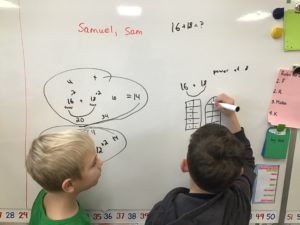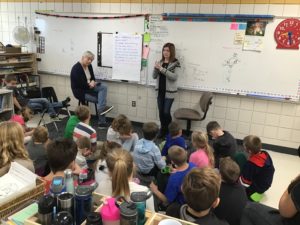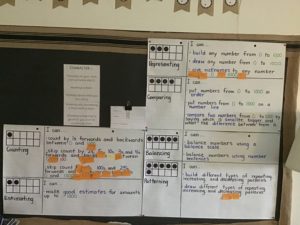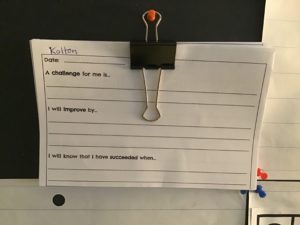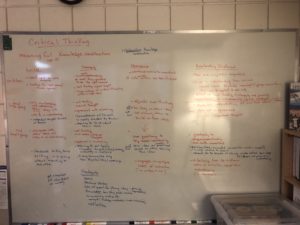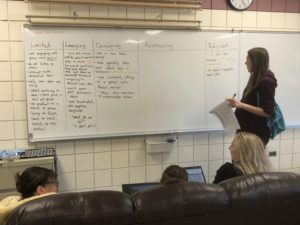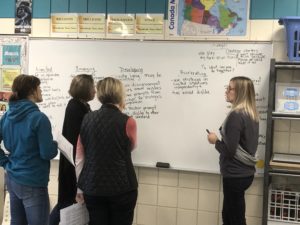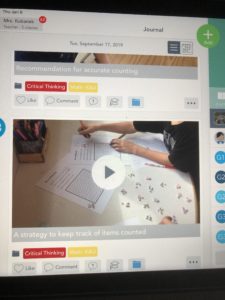Developing Competencies For Life
Global competence is having the tools to meet the problems and opportunities of this world. As we develop combinations of attitudes/dispositions, skills, and knowledge, we are actually developing the competencies that help us to thrive in living and learning. These are developed over time and through circumstances, and can be viewed as a valuable transferrable skillset. Our formalized education system, with learners of all ages and backgrounds is such a ripe opportunity for developing global competence for today and tomorrow’s world. What are those dispositions and skills for this global competence? Our school division has chosen to emphasize collaboration, communication, character, citizenship, creativity, and critical thinking.
Difference Between Skills and Dispositions
Kath Murdoch, author of The Power of Inquiry, describes skill sets that we need and use as learners. Within these broader skill sets (our Cs) are more specific skills. She distinguishes between skills and dispositions by noting that skills are more about what the learner is doing whereas dispositions are more about what the learner is ‘being’. She notes in her book that many argue that without dispositions, skills are carried out much less effectively. She gives the example that “one can be skilled at formulating a rich question for inquiry, but without curiosity to want to find out, the courage to go beyond the known, and an open-minded attitude about the information gathered, then the skill of asking questions is of little real value”.
Connecting Curriculum with Competencies – Split Screen Planning
How can we nurture skills and dispositions so that the ‘how’ and ‘why’ of learning is aligned with the ‘what’ of learning? A few years ago, the term, ‘split screen planning’ filtered into our Hanover School Division’s realm. The split screen thinking model is based on Guy Claxton’s work – looking at two processes or multi-processes at once. What am I learning? How am I learning? Learning to do. Learning to be. While we, as teachers, may have a curricular lesson sequence and activities that support an important big idea in the curriculum, we can also encourage and help develop one or more key, relevant competencies that a learner can then reflect on so as to broaden and better their use of global skills. For example, learners in gr. 3 and 7 learn about the design process as they manipulate and test materials, build structures, and investigate internal and external forces acting on structures. Learners also develop collaborative skills as they build and test materials together while critically thinking about decisions along the way and make conclusions based on analysis. Perseverance will also be needed during the design process. Herein lies the potential, almost seamless weaving of curriculum and competency work. This blending of curriculum and the competencies is not a new concept. However, I wonder how we could work towards more intentionality developing the competencies in our students?
Are we seeking, as teachers, the intricacies of any given particular competency? Are the learners understanding the need for the competencies within curricular work and the ways to develop them? Are they part of developing criteria for this? Do they reflect on themselves as learners?
Time to Reflect
“We don’t learn from experience. We learn from reflecting on experience.” Reformer John Dewey has been talking about the importance of reflection in the learning process since the 1930’s. Reflection is a vital part of the learning process. What if we encouraged our learners to reflect not only on their academic growth but also on their competency growth? What would it sound like if we modelled and then asked our students to talk about themselves as learners? What if they reflected not only after learning but also before learning and in learning? The idea of reflection on “I am learning about…” and “I am learning to be… ” can be at ANY point in the process and brings power to the learning. Build reflective thinking into the daily routine. Teach students how and expect this as part of what we do. The result is surely to bring about more mindful, effective learners.
Intentionality
Early on this year at LES, teachers in the Gr. 2/3 class were noticing the need for increasing self-regulation and responsibility for learning in their students (noted as one of the dimensions of the Character competency). After brainstorming together in one their collaborative learning sprint meetings, the teachers decided to take some steps with their students. One of the teachers read the student-friendly NPDL version of the dimension labelled, Self-regulation and Responsibility for Learning and asked, “What does that look like in our classroom?”. The teacher incorporated specific talk moves in preparation for discussion such as signs for agreeing, disagreeing , and adding on. This protocol encouraged intentional discussion that had potential to challenge thinking. The teacher typed out the big ideas she heard in the discussion and then went on to ask, “How can we tell if something is challenging for us?” Thoughts and ideas as to what to do when things get challenging were recorded. For both numeracy and literacy stations that were available to students, specific curricular skills were made visible as well as the co-constructed criteria from the earlier discussions for how to self-regulate and be responsible for their learning.
Students used a sticky note to mark which skill they found particularly challenging and would need more practice on. They also put a sticky note beside a skill that they felt confident in. These reflections happened at various points in the learning process and the sticky notes were adjusted accordingly. The teachers worked diligently alongside their students to support them with their learning goals, which included both curriculum and competency work. Increasing self-regulation and responsibility for learning by giving clarity about learning outcomes and success criteria can help students to know where they are going and when they get there so they will be better able to set own expectations and self-report their own achievement. (Hattie’s effect size on self-reporting own achievement – 1.44)
Making Meaning of the Competencies
An earlier question posed was, “Do we know, as teachers, the intricacies of any given particular competency?” We’ve begun this work of making sense of the six global competencies by looking the various dimensions within each of them. Until we take time to delve into them, we may tend to view the competencies vaguely. Misconceptions are easy to make as we tend to base our understanding on current schema. Isn’t collaboration the same as group work? Doesn’t communication focus on volume of voice and eye contact with audience during a presentation? We have many questions and before we can intentionally help develop the Cs, fairly evaluate how our students are growing in the Cs, or ask them to reflect on their own growth, we are best off digging in deeper into the dimensions and the specifics of the Cs for our own understanding. Remember as well, that the learning experiences we offer our students need to provide rich opportunities for competency development.
This work of developing our teacher understanding has begun in schools around our division. In both Kleefeld School and LES, time in the fall was given for grade-level collaborative groups to meet and choose a competency that teachers felt was pertinent to the current curricular work and overall classroom needs. Within that chosen competency, a dimension was examined. This work included discussing what the stages of limited evidence, emerging, developing, accelerating, and proficient look and sound like in a particular dimension of a C for their particular grade level. Teachers were encouraged to keep in mind the developmental stages of their students as they recorded this. This meant that there was potential that a student in any given grade could reach the accelerating or proficient stages. Each collaborative group’s work was then shared with the rest of the teachers. This work gave traction to co-constructing criteria for a given dimension with their students to be referred to in the days ahead. Next steps include a check-in as to the steps teachers are taking in providing learning and growing opportunities for the combined competency and curricular work as well as the incorporation of frequent student reflection, considering what this could look like before learning, in learning, and after learning. The digital tool, Seesaw, is a great way to capture those reflections!

